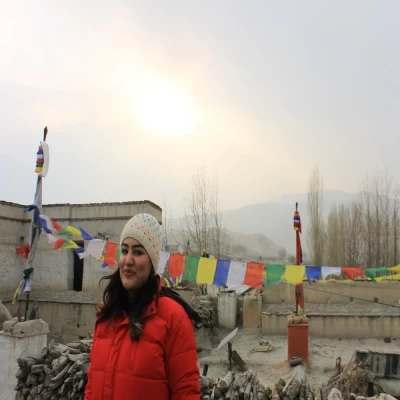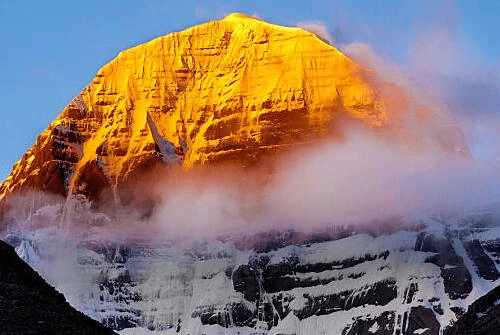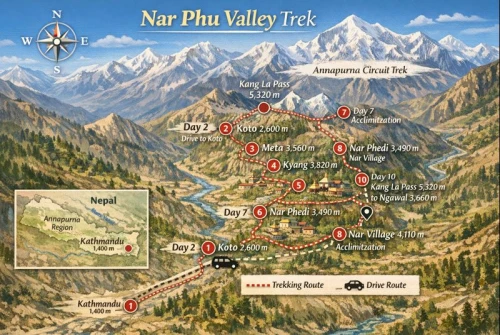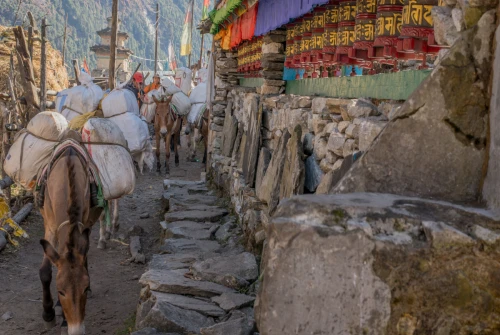Nepal’s rugged terrain and vibrant culture make Family Trekking in Nepal an unforgettable experience, especially when thoughtfully planned to suit every age and ability. From toddlers riding comfortably in child carriers to teens eager for adventure, Nepal Trekking with Kids offers a safe yet thrilling introduction to the Himalayas. Many parents begin with the Best Family Treks in Nepal routes, specifically chosen for gentle ascents, moderate daily distances, and plentiful village stops. If you are trekking in Nepal for Beginners, consider the ever‑popular Ghorepani‑Poon Hill loop or the lower sections of the Annapurna region: both rank among the easiest treks in Nepal while still delivering sunrise panoramas over snow‑capped giants.
A true Nepal family adventure weaves short hiking days with cultural immersion, helping children connect deeply with local life. Opt for Short treks in Nepal that pass traditional Gurung or Tamang settlements, where you can sip butter tea with elders, spin prayer wheels at hillside monasteries, and watch your kids’ faces light up as they learn simple Nepali phrases from new friends. These trails double as Cultural treks in Nepal, blending outdoor exercise with heritage lessons.
Parents often ask, “Is trekking in Nepal safe for kids?” Yes, provided you choose age‑appropriate itineraries, acclimatize gradually, and stick to well‑traveled paths. Guides trained in wilderness first aid elevate confidence, and consistently maintained lodges ensure Safe trekking in Nepal even at higher altitudes. Most families favor Teahouse trekking in Nepal, where private rooms, hearty dal bhat, and warming stoves erase the need to carry camping gear, leaving space for storybooks, snacks, and a favorite plush toy.
Because daytime hikes rarely exceed four hours, energetic youngsters still have plenty of time for meadow picnics and momos‑making lessons, ticking every box for Hiking in Nepal with children. These carefully curated, family-friendly trekking routes also present shorter contingency legs in case little legs tire early. Planning around weather is crucial: the best time for trekking in Nepal with family is October–November or March–April, when skies are crystal‑clear, temperatures are mild, and rhododendrons or post‑monsoon greenery paint the hillsides.
“What are the best family treks in Nepal?” Beyond Poon Hill, consider the Langtang Valley, famed for gentle gradients and yak pastures, or the lower Mustang trail, where desert landscapes contrast dramatically with snowy Annapurna peaks. For extended adventures, craft a Nepal trekking itinerary for families that links a few of these pockets via comfortable jeep transfers, minimizing total walking hours while maximizing scenery diversity.
Wondering how to plan a family trek in Nepal? Start by researching distances, daily elevation gains, and lodge availability; next, consult reputable local agencies for porter‑guide ratios that respect ethical labor standards. Finally, pack light layers, sun protection, and favorite snacks, plus altitude‑appropriate medicine approved by your pediatrician.
These practical preparations unlock precious memories: songs echoing across pine forests, shared laughter during card games by the hearth, and that triumphant moment when everyone summits Poon Hill at dawn. Take note of our expert Tips for trekking with kids in the Himalayas: walk slowly, hydrate often, celebrate small milestones, and you’ll craft a seamless Family travel guide to trekking in Nepal.
For many, the absolute Best family trekking experience in the Annapurna region ends with a hot‑spring soak in Tatopani or a lakeside paddle in Pokhara. Whether you opt for a weeklong loop or shorter out‑and‑back, countless operators now design bespoke Nepal trekking holidays for families, ensuring that every step blends adventure, education, and Himalayan hospitality into a lifelong bond.
Why is Nepal a Great Destination for Family Treks?
Nepal is one of the world’s most family-friendly trekking destinations, offering a perfect mix of adventure, nature, and culture. With a wide range of beginner-friendly trails, well-established teahouses, and experienced local guides, families can explore the Himalayas safely and comfortably. Kids and adults alike will enjoy the chance to walk through traditional villages, interact with locals, and witness mountain views that inspire awe.
The country’s warm hospitality, delicious food, and manageable trekking options make Nepal ideal for multigenerational travel. Whether it’s a short hike or a weeklong journey, Nepal promises unforgettable memories for the whole family.
What makes Nepal so very special for a family trek?
Nepal is special for family treks because it combines natural beauty with cultural richness in a way few other countries can. Trekking routes often pass through charming villages, rice terraces, rhododendron forests, and sacred monasteries, making every day a learning experience. Families can stay in cozy teahouses, enjoy homemade meals, and meet kind-hearted locals who love welcoming children. The relatively low costs and flexibility of routes also add convenience. From spotting Himalayan peaks to hearing stories from guides, every part of the journey brings families closer together. Nepal’s peaceful trails offer both relaxation and discovery, making it a unique destination.
But what about the altitude?
Altitude is a valid concern, especially for families with young children, but it can be managed safely with proper planning. Many treks in Nepal are at lower elevations like Ghorepani-Poon Hill, the Ghandruk Loop, or parts of the Langtang Valley, which are suitable for families and don’t pose serious risks.
Slow-paced trekking, hydration, rest days, and gradual ascent help minimize altitude sickness. Professional guides are trained to recognize symptoms and take appropriate measures. Families are advised to consult their doctor before travel and choose a trek that matches everyone’s comfort level. With awareness and precautions, altitude doesn't have to be a barrier.
Is Nepal a good fit for your family's next adventure?
Absolutely! Nepal is a perfect fit for families seeking a unique blend of nature, culture, and adventure. Unlike typical vacations, a family trek in Nepal encourages outdoor activity, learning through travel, and a deeper connection through shared challenges and discoveries. Children can experience different ways of life, learn about Himalayan wildlife, and build confidence through hiking.
Parents can enjoy stress-free logistics with support from guides and porters. Whether it’s walking through flower-filled forests or sipping tea with locals, every moment is enriching. Nepal provides a safe, welcoming, and inspiring environment for families to grow, explore, and create lifelong memories together
How to Choose the Right Trek for Your Family's Fitness Level?
Choosing the right trek starts with understanding your family’s physical abilities, ages, and interests. Look for treks that offer gentle trails, minimal altitude gain, and shorter daily distances, typically 3 to 5 hours of walking per day. Routes like Ghandruk, Poon Hill, or lower Mustang are ideal for beginners and families with kids. Avoid high-altitude routes unless everyone is well-prepared.
Consult a trekking agency that specializes in family travel, they’ll recommend suitable itineraries and offer customization. Also, consider adding cultural experiences, nature walks, or jeep transfers to reduce fatigue. The right trek will balance adventure with comfort and enjoyment for everyone.
Best Family-Friendly Trekking Routes in Nepal
Ghorepani Poon Hill Trek
The Ghorepani Poon Hill Trek is one of the most accessible and family-friendly treks in Nepal. Located in the Annapurna region, this trail is relatively low in altitude and offers an excellent combination of natural beauty and cultural immersion.
The highlight of the trek is the early morning hike to Poon Hill (3,210 meters), where we’re rewarded with panoramic sunrise views over some of the world’s tallest peaks. The trail passes through lush rhododendron forests, vibrant Magar and Gurung villages, and cascading waterfalls. Daily walking distances are manageable (3–5 hours), and the route includes numerous cozy teahouses with hot meals and warm beds. For families with younger children, this trek provides all the excitement of a Himalayan adventure without the physical strain or altitude challenges.
Trekking Itinerary
Day 1: Arrival in Kathmandu
Day 2: Drive from Pokhara to Nayapul and trek to Tikhedhunga.
Day 3: Trek from Tikhedhunga to Ghorepani.
Day 4: Early morning hike to Poon Hill, then trek to Tadapani.
Day 5: Trek to Ghandruk.
Day 6: Trek from Ghandruk to Nayapul and return to Pokhara.
Day 7: Drive or fly from Pokhara to Kathmandu
Langtang Valley Trek
The Langtang Valley Trek is an excellent choice for families seeking a more immersive Himalayan experience without venturing too far from Kathmandu. After a scenic drive from the capital, we begin trekking through Langtang National Park, home to red pandas, Himalayan deer, and a wide variety of birds. The route ascends gently through beautiful forests and charming Tamang and Tibetan-influenced villages. Reaching Kyanjin Gompa at 3,870 meters, we can explore ancient monasteries, cheese factories, and enjoy day hikes with incredible glacier views.
The trail is less crowded than the Annapurna or Everest regions, offering a tranquil experience ideal for older children and teens who enjoy nature, wildlife, and learning about local culture. With plenty of guesthouses and a moderate difficulty level, Langtang is a great mid-range family trekking option.
Itinerary:
Day 1: Arrival in Kathmandu
Day 2: Drive to Syabru Besi (1460m), 8 hrs
Day 3: Syabrubensi to Lama Hotel (2410m), 5-6 hrs
Day 4: Trek from Lama Hotel to Langtang Village 5-6hrs
Day 5: Langtang Village to Kyanjin Gompa (3730m), 4-5 hrs
Day 6: Explore Kyanjin Gompa & visit Tsergo Ri (8 hrs)
Day 7: Kyanjin Gompa to Lamahotel, 7-8hrs
Day 8: Lamahotel to Syabrubensi, 5-6 hrs
Day 9: Trek from Syabrubensi to Kathmandu, 7-8 hrs
Day 10: Fly to the onward destination
Australian Camp and Dhampus Trek
If we're trekking with small kids or seniors, the Australian Camp and Dhampus Trek is a short but rewarding route that offers stunning views with very little effort. This trek begins near Pokhara, and we quickly ascend to Australian Camp (2,100m), where the views of the Annapurna and Machapuchare peaks are truly breathtaking.
The trail continues to Dhampus, a traditional Gurung village where we can experience rural Nepali hospitality and culture firsthand. The hike is relatively short, just a few hours each day, and the elevation is low, so there's minimal risk of altitude sickness. Families love this trek for its scenic beauty, easy trails, and opportunities to relax in nature while still enjoying the majestic mountain views. It's the perfect introduction to trekking in Nepal for first-timers and families with small children.
Itinerary
Day 1: Arrival in Kathmandu (1,400m)
Day 2: Drive to Kande and trek to Australian Camp (2,100m)
Day 3: Trek to Phedi via Dhampus Village, Drive to Pokhara
Day 4: Drive or fly from Pokhara to Kathmandu. Trip ends
Everest Panorama Trek
For families who want to experience the allure of Mount Everest without committing to the full base camp journey, the Everest Panorama Trek is the ideal compromise. Starting with a thrilling flight to Lukla, we follow the classic Everest trail through charming Sherpa villages like Phakding and Namche Bazaar.
Instead of continuing to Everest Base Camp, we trek up to the beautiful Tengboche Monastery (3,870m), which offers clear views of Everest, Ama Dablam, and Lhotse. This route is shorter and less strenuous than the full EBC trek but still provides the dramatic landscapes, cultural richness, and excitement of being in the Everest region. With proper acclimatization and rest, the trek is suitable for older children and teenagers, especially those fascinated by mountains and Buddhist culture.
Itinerary:
Day 1:Arrival in Kathmandu
Day 2:Trek Preparation
Day 3:Kathmandu-Phakding
Day 4:Phakding to Namche Bazaar
Day 5:Acclimatization day at Namche Bazaar
Day 6:Namche Bazaar-Tengboche monastery
Day 7:Tengboche-Monjo
Day 8:Monjo-Lukla
Day 9:Lukla-Kathmandu
Day 10:Departure Day
Helambu Trek
The Helambu Trek is one of the most underrated and accessible family treks in Nepal. Located just north of Kathmandu, this trail offers stunning Himalayan views, rich Tibetan Buddhist culture, and peaceful forests without the crowds of more famous trekking routes. The villages here are home to the Hyolmo people, known for their warm hospitality and unique customs.
The trail moves through dense pine forests, terraced fields, and alpine meadows, gradually gaining altitude to a manageable 3,600 meters. This trek is perfect for families seeking a quiet and cultural hiking experience with the convenience of being close to the capital. It’s especially well-suited for families with older adults or those who want a gentler pace and fewer tourists.
Itinerary:
Day 1:Trek from Kathmandu to Chisapani (2215m)
Day 2: Chispani to Kutumsang(2470m)
Day 3:Trek from Kutumsang to Tharepati(3510m)
Day 4: Trek from Tharepati to Melamchigaun(2530m)
Day 5: Melamchigaun to Tarkeghayang(2740m)
Day 6: Trek from Tarkeghyang to Sermathang(2590)
Day 7: Trek from Sermathang to Melamchu Bazar(870m)
Day 8: Melamchi Bazar to Kathmandu
Essential Tips for a Safe and Enjoyable Family Trek
Choose the Right Trek Based on Family Age and Fitness
Not all treks are appropriate for every family. The key to a successful experience is choosing a route that matches the fitness level and interests of everyone involved. For families with younger children, short treks with minimal altitude gain are ideal. For teens and fit adults, more adventurous options like Langtang or Everest Panorama may be suitable. It’s essential to select a trek with well-paced itineraries, ample rest stops, and safe accommodations.
Acclimatize Gradually
Altitude sickness can affect anyone, regardless of age or fitness level. When trekking above 2,500 meters, we must allow time for our bodies to adapt. This means incorporating rest days into the itinerary, ascending slowly, and drinking plenty of fluids. Treks like Poon Hill and Australian Camp are lower in altitude, making them safer for children. For higher treks like Langtang or Everest Panorama, it's critical to follow proper acclimatization practices.
Hire a Local Guide and Porter
Hiring a certified local guide greatly enhances our trekking experience. Guides ensure safety, help with logistics, and provide cultural insights that make the journey more meaningful. Porters can carry luggage, which allows us to focus on enjoying the scenery and helping our children along the trail. Supporting local guides and porters also contributes directly to the local economy and enhances our connection to the region.
Carry Trekking Essentials
Being well-prepared is crucial. Each family member should have proper trekking gear, including sturdy shoes, weather-appropriate clothing (layers are best), sun hats, sunscreen, reusable water bottles, and personal hygiene supplies. Snacks, entertainment (like cards or books), and small first aid kits are useful, especially when trekking with kids. Don’t forget a camera to capture those unforgettable family moments!
Embrace Local Culture and Food
One of the most enriching aspects of trekking in Nepal is experiencing the local culture. Encourage children to try traditional dishes like Dal Bhat, learn a few Nepali phrases, and participate in cultural activities. Visiting monasteries, chatting with local families, and understanding different ways of life help children develop global awareness and empathy.
Prioritize Hygiene and Accommodation
Family comfort and health are essential, especially on the trail. Choose teahouses that offer private rooms, clean bedsheets, hot meals, and hygienic bathrooms. Many popular trekking routes offer modern amenities like solar-powered showers, Wi-Fi, and phone charging stations. Good accommodation can make a significant difference in everyone’s enjoyment, especially for young kids and older adults.
When Is the Best Time for Family Trekking in Nepal?
The best seasons for family trekking in Nepal are spring (March to May) and autumn (September to November). These periods offer clear skies, pleasant temperatures, and ideal trail conditions. In spring, blooming rhododendrons and greenery make the trails especially vibrant. Autumn offers stable weather and excellent visibility. Winter (December to February) is suitable for lower-altitude treks like Dhampus and Australian Camp, though nights can be cold. Monsoon season (June to August) is generally not recommended due to slippery trails and leeches, but rain-shadow regions like Mustang remain viable.
Conclusion
Our family-friendly trekking package is carefully designed to ensure comfort, fun, and safety for travelers of all ages. It includes short trekking days, child-friendly meal options, comfortable teahouse stays, and experienced guides trained to work with families.
Cultural activities like visits to schools or monasteries, and interaction with local children are built into keep young ones engaged. Porters help lighten the load, so you can focus on enjoying the experience. The itinerary is flexible, allowing for rest days or adjustments based on your family’s needs. This package offers the perfect balance of adventure, learning, and relaxation.
Family trekking in Nepal is more than a vacation; it’s a shared adventure, a journey of discovery, and an opportunity to grow closer to nature and each other. Whether we’re crossing suspension bridges, sipping tea in a mountain village, or watching the sunrise over snowy peaks, these are the moments that stay with us forever. With careful planning, the right route, and a spirit of adventure, we can create experiences that our family will cherish for a lifetime.



